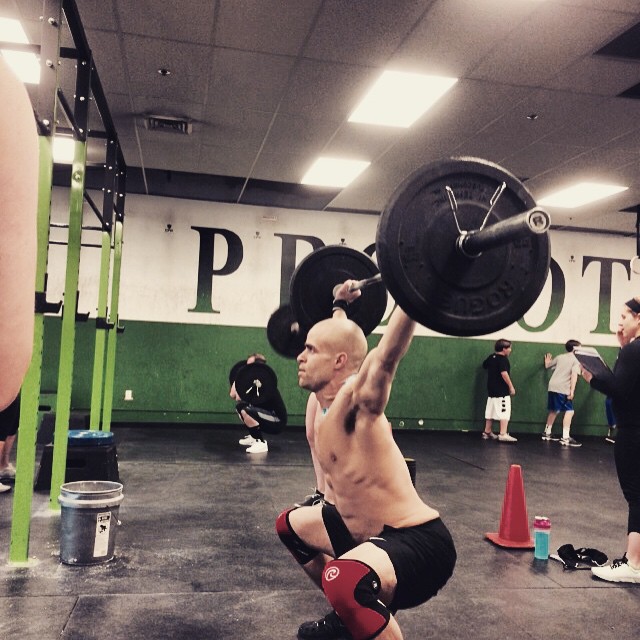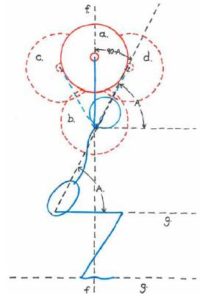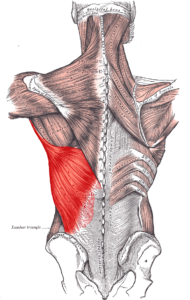By: Mike Collette (Head Coach/Owner of CrossFit Prototype)
This 5-part blog series will cover the five hardest movements/exercises that we see in CrossFit gyms. For the seven years that I have been in the fitness industry and as a personal fitness trainer, I have seen a lot and tried a lot of different things in pursuit of improving my overall fitness. What I have learned over the course of that time is that there are an endless number of different exercises that you can do to attain a desired response and effect. With that said, each one of these movements vary in degree of difficulty due to particular limiting factors. The biggest limiting factor when it comes to many movements is overall motor control and gross coordination. Beyond the mental aspect of skill acquisition, we find that overall mobility and stability limitations are another area that can make an exercise seem almost unattainable. Furthermore, some exercises are inappropriate for some individuals based on current movement limitations, prior history of injury and you could argue age.
In part 2 of this mini blog series I will address (in no particular order) five of the most challenging movements that you might see in a CrossFit class or in any fitness facility for that matter.
“Stability is how well we can maintain a position in the presence of change. This is the one people really get mixed up. Stability doesn’t mean I can hold a position. For our purposes, if you use the word “stable” to cue somebody to get what you want, by all means use it. But for the purposes of understanding the joint-by-joint concept, it means the ability for a joint or joint system to control movement in the presence of potential change.” ~Charlie Weingroff
The Overhead Squat

One of my favorite exercises as a trainer and personal fitness instructor, the overhead squat allows you to express the relationship between mobility and stability. At CrossFit Prototype, we use this exercise not only as a means to develop and express total body strength but also as a movement assessment. From the assessment point of view, the overhead squat can tell us a lot. Here is a list of potential movement faults when performing the overhead squat (just to name a few):
The quote by Charlie Weingroff above states what stability actually is. For those who have never performed or attempted to perform an overhead squat, you need to maintain a stable overhead position while creating “change” as you perform a squat. More than not, we tend to see people that are hypo-mobile (less mobility), so they are a little stiff or potentially immobile. The overhead squat (OHS) is a perfect testament to the synergy between mobility and stability.When someone has a mobility limitation, they automatically have a motor control challenge. As I like to explain this movement to people, the OHS requires a few prerequisites before we load it.
- Forward lean (can’t maintain upright torso)
- Lack of depth (does not have the ability to reach full range of motion with arms overhead)
- Squatting on toes (weight distribution is on front of foot)
- Knee valgus (Knee’s cave in, don’t track in line with toes)
- Arms fall forward (can’t maintain PVC pipe/bar overhead)
- Rounded back/change of pelvic position (lower back rounds and pelvis moves from stable position to unstable position)
- Weight shift (sitting into one side of the hip more than the other)
As you can see, there are many things that can go wrong when performing this movement. The scope of this article isn’t to go into the details of the specific movement faults and their causes, that is a whole other post in itself! What I will talk about is the high-level issues and some fast fixes we can do to make this exercise a little more palatable!
1.) Motor control (this is seen in movement patterns)
2.) Mobility (ability to move through a desired range of motion)
3.) Stability (control movement in the presence of change)
4.) Balance (in this case, static balance)
5.) Strength (amount of force production against a resistance)
Take a look at Bill performing the overhead squat below:
If you watch the video, Bill executes this movement flawlessly because of his ability to move well and create stability. Now, movement limitations might not be seen with a PVC pipe due to lack of resistance or enough stimulus to elicit a change in the pattern, so to truly get some feedback you would want to test this out with a barbell. But why does Bill make this look so easy and why might this not be as easy for you? Check the pre-requisites!
1.) Motor Control
Motor control, simply put, is the ability for your brain to coordinate movement patterns. Proper movement is learned and developed through practice. If you learn how to do a movement incorrectly, that will become your motor pattern unless you learn how to move correctly. Now if years and years go by practicing poor movement patterns, it takes time to train your brain to get into good positions when trying to correct the fault(s). More often than not, challenging a proper movement pattern is one of the best ways to move better vs. just stretching your “hamstrings”. Think about postural positions and your body alignment over the course of the day. Many of you are aware of your posture and understand the relationship between sitting for eight hours at a desk, two hours in the car and three hours on the couch watching TV and how your body might create adaptation to those positions. Your body will also create adaptation if you challenge it to be in a good position as well!

The Fix:
If you feel that coordinating the movement is your biggest limitation, slowly practice and work into the overhead squat position with a PVC pipe to limited range of motion. OHS (overhead squat) to a box and/or wall facing overhead squats are great ways to practice this pattern and get into a good position. This is a slow and steady progression, it’s not something that will necessarily happen overnight so be patient. When you feel confident with the wall facing squat, load up the OHS and see how it feels.
2.) Mobility
Having the ability to move freely at and around joint surfaces is what mobility truly is. The overhead squat raises your arms overhead and forces you to maintain a stable overhead position while challenging the mobility at the shoulder (think about your lat’s pulling your arms down), mobility at the ankle (ability for your ankle to dorsiflex while you squat), and mobility at the hip to reach the desired range of motion. If we are stiff in any of these areas, it makes performing the overhead squat even more challenging.
“Tight lat’s” are often times a major culprit in getting into a good overhead position. Your Lat’s (Lattissimus Dorsi, see below) are responsible for extension at your shoulder and adduction at the shoulder. The OHS forces you to be flexed at your shoulder and abducted, the exact opposite of what the Lat is responsible for. So if you struggle with your overhead position, take a look at the Lat’s and surrounding structure.

(Wikipedia image)
Bill’s ankle mobility is quite significant giving him an edge to maintain an upright torso position. In addition, hip mobility/flexibility and proper squat pattern enables him to reach an appropriate depth. From there the mid-line is involved in creating stability while bracing and people with upper body movement limitations such as upper crossed syndrome/ tight lats/ kyphotic posture/tight T-spine/shoulder mobility issues etc, (the list goes on) might exhibit lack of mobility and stability in that overhead position. As you can see, I actually have Bill move his hands in on the OHS, challenging his mobility but creating more stability through the movement. All in all, Bill has awesome mobility but needs to be managed with proper stability training.
The Fix:
Soft tissue work (SMR; self-myofascial release) is imperative to free up stiffness in order to get in a good position. The areas you want to tackle most likely are your feet, calves, hip flexors, and lats. These are some of the biggest muscles that can inhibit you from getting into a good position. If you feel your ankle mobility is the limiting factor, take a look at my blog post on the pistol squat which goes into a couple drills on improving mobility at the ankle (Part 1 of the 5 most challenging movements in CrossFit). Movements that create length at the tissue while you relax and breath through those positions will help improve mobility but doing this on a consistent basis is even more important if you want to make a significant change.
3.) Stability
As I have mentioned previously, stability is how well we can maintain a position in the presence of change. If you are a hyper-mobile person (moving beyond desired range of motion. Bill actually has some hypermobility) you require more stability to maintain positions vs. more mobility work to get you into a good position. Stability in the overhead squat is seen most at the shoulder complex and midline. If we lack a stable shoulder position as we move through a range of motion during the squat, keeping that bar overhead becomes your biggest challenge, not standing the weight up from the bottom! If you lack midline stability, as you continue to load the overhead squat it becomes challenging to brace and control your core. We want to think about bracing for a punch at your midline when going for a relatively heavy OHS.
The Fix:
As you can see in the video of Bill doing the OHS, I narrowed out his hands to challenge his mobility and create a more stable overhead position. For someone with stability challenges vs. mobility challenges you can narrow their grip and this movement becomes easier for them to maintain. Someone with mobility restrictions it is the exact opposite and you would actually widen their grip potentially. In addition to narrowing the grip, accessory stability work such as overhead waiter’s carries, farmers carries, and crawls will help develop stability at the shoulder and rotator cuff. As it pertains to midline stability, breathing and bracing drills such as deadbugs, RKC planks and pallof presses are great exercises to assist with creating rigidity at the midline.
4.) Balance
Balance can often be interpreted in the context of stability or motor control but plays a roll in the accuracy of the overhead squat movement. If you feel like you are constantly falling over in the OHS, this can be due to a movement/mobility limitation which causes balance issues. To add, you might feel the urge to fall over because your motor control isn’t quite there yet.
The Fix:
Isolated balancing drills can be helpful (such as single leg work) but the reality is is you might benefit most from slowing the pattern down and getting into a good position with assistance such as a box or implement to squat to.
5.) Strength
If you move well, have stability in the OHS position and can coordinate movement well, your issue is overall strength development. This is really important more so when it comes to loading the OHS. If you struggle with the PVC pipe OHS in terms of just standing up, you have a big capacity to make strength gains and build strength on your awesome movement patterns.
The fix:
For people who really need to develop baseline strength should skill the OHS more so than try to build significant strength with it. Instead, your focus should be on other gross movement patterns such as goblet squats, front squats and back squats in addition to working on midline and shoulder stability.
